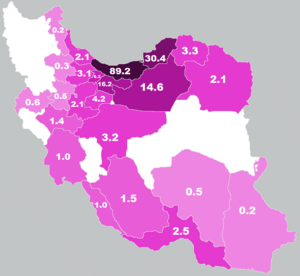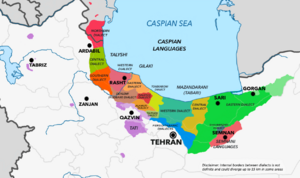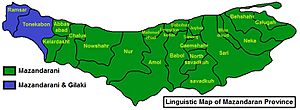Mazanderani language facts for kids
Quick facts for kids Mazandarani |
||||
|---|---|---|---|---|
| مازرونی (Mazoruni) طبری (Tabari) |
||||

Mazanderani (Mazoruni) written in Nastaliq script. (مازرونی)
|
||||
| Native to | Iran (Province of Mazandaran and parts of the provinces of Alborz, Tehran, Qazvin, Semnan and Golestan) | |||
| Region | South coast of the Caspian Sea | |||
| Ethnicity | Mazanderani people | |||
| Native speakers | 2 million (2019)e25 | |||
| Language family |
Indo-European
|
|||
| Dialects |
Gorgani-Mazandarani (East)
Katuli-Mazandarani (East)
Tabari-Mazandarani (Center)
Kojuri-Mazandarani (West)
Kelarestaqi-Mazandarani (West)
Gilaki-Mazandarani (West)
Galeshi-Mazandarani (South)
Taleqani-Mazandarani (South)
Shahmirzadi (South)
Ilikaei (South)
Qasrani (South)
|
|||
| Writing system | Persian alphabet | |||
| Official status | ||||
| Regulated by | None. But the Linguistic faculty of Mazandaran University officially gathers materials and resources about it. | |||

Areas where Mazandarani is spoken as the mother tongue
|
||||
|
||||
Mazandarani (مازندرانی), also known as Tabari (طبری), is a language spoken by the Mazandarani people. It belongs to the Iranian languages family, specifically the Northwestern branch. As of 2019, about 2 million people speak Mazandarani as their first language.
Mazandarani is closely related to the Gilaki language. Both languages share similar words and some unique features with languages from the Caucasus region. This shows their historical connections to that area. Mazandarani is also related to Persian, though Persian is from a different branch of Iranian languages. Even with Persian's influence, Mazandarani remains its own distinct language.
Contents
What's in a Name?
The name Mazandarani comes from the historical region of Mazandaran. People often call their language Tabari because it was traditionally spoken in the ancient area known as Tapuria. Young people today sometimes prefer the name Tabari.
Early writers, like Al-Muqaddasī in the 10th century, mentioned the language of Tabaristan (another name for Mazandaran). They noted it was similar to languages in nearby regions but spoken more quickly.
A Look at History
Mazandarani has a long written history, dating back from the 10th to the 15th centuries. This was when independent rulers in Mazandaran helped the language grow.
Important books like Marzban Nameh and poems by Amir Pazevari were written in Mazandarani. However, its use in literature and government started to decline in the 17th century. This happened when Mazandaran became part of the larger Iranian government.
Where is it Spoken?
Mazandarani is closely related to Gilaki, and they have many similar words. In 1993, around three million people spoke Mazandarani.
The language has many different ways of being spoken, called dialects. Some of these include Saravi, Amoli, Baboli, and Shahmirzadi. People in cities like Sari, Babol, Amol, and Chalus are Mazandarani people and speak this language.
How the Language Works
Mazandarani is an inflected language, meaning words change their endings to show their role in a sentence. It does not have grammatical gender, unlike some other languages. The usual word order is Subject-Object-Verb (SOV), but in some dialects, it can be Subject-Verb-Object (SVO).
Word Forms
In Mazandarani, nouns don't change much for different roles in a sentence. You can often tell their role from the word order. To make a noun definite (like "the house"), you add the suffix e (for example, me dətere means The daughter of mine). For indefinite nouns (like "a girl"), you use a-tā (a-tā kijā).
Long ago, female nouns used to end in a and male nouns in e. For example, jənā meant the woman and mərdē meant the man. Some related languages still have grammatical gender today.
How Words Connect
Mazandarani uses words placed after other words to show their relationship, unlike English or Persian which mostly use words before (prepositions). These are called postpositions.
Some common postpositions are:
| Postposition | Meaning |
|---|---|
| dəle | in |
| re | of / to |
| je | from / by |
| vəse | for |
| tā | to |
| həmrā / jā | with |
| səri | on / above |
| bəne | under / below |
| pəli | near / about |
| vāri/ tarā | like |
| derū | among / inside |
Word Endings (Suffixes)
Mazandarani uses suffixes, which are small parts added to the end of words, to change their meaning.
Place Suffixes
These suffixes tell you about a place:
| Suffix | Example | Meaning |
|---|---|---|
| Kash | Kharkash | Good place |
| Kel | Tutkel | Mulberry limit |
| Ij | Yoshij | Yoshian |
| Bun | Chenarbon | At the plantain |
| Ja | Səre Ja | Relating to home |
| Sar | Bənesar | Underneath |
Action Suffixes
These suffixes describe someone who does an action:
| Suffix | Example | Meaning |
|---|---|---|
| Chaf | Au Chaf | Water-sucker |
| Rush | Halikrush | Berry-seller |
| Su | Vərgsu | Wolf-hunter |
| Kaf | Ukaf | One who performs actions in water |
| Vej | Galvej | Mouse-finder |
| Yel | vəngyel | Bandmaster |
How it Sounds
Mazandarani has specific vowel and consonant sounds. Some sounds might change slightly depending on where they are in a word or which dialect is being spoken.
Vowel Sounds
| Front | Central | Back | |
|---|---|---|---|
| Close | i | u | |
| Mid | e | ə | o |
| Open | a | ɑ |
Consonant Sounds
| Labial | Dental/ Alveolar |
(Palato-) alveolar |
Velar | Uvular | Glottal | ||
|---|---|---|---|---|---|---|---|
| Nasal | m | n | |||||
| Stop/ Affricate |
voiceless | p | t | t͡ʃ | k | q | (ʔ) |
| voiced | b | d | d͡ʒ | ɡ | (ɢ) | ||
| Fricative | voiceless | f | s | ʃ | x | h | |
| voiced | v~(w) | z | ʒ | ʁ | |||
| Approximant | l | j | |||||
| Tap/Flap | ɾ | ||||||
How it's Written
Mazandarani is usually written using the Perso-Arabic script, which is similar to the alphabet used for Persian. Sometimes, people also use the Roman alphabet, especially for things like text messages.
Words and Their Meanings
Because it's protected by the Alborz mountains, Mazandarani has kept many old Indo-European words. These words are no longer common in modern Iranian languages like Persian.
Here are some common Mazandarani words that have ancient roots:
| English | Mazanderani | Persian | Vedic | Proto-Indo-European | Example of |
|---|---|---|---|---|---|
| new | neo | no / now | návas | *néwos | adjective |
| great | gat | bozorg, gozorg, gonde, got | adjective | ||
| better | better | behtar | adverb | ||
| been | bine | budeh | auxiliary verb | ||
| being | bien | budan | bhū- | *bʰuH- | infinitive of verb |
| father | piar | pedar | noun | ||
| mother | mâr | mâdar | noun | ||
| brother | berar | barâdar | noun | ||
| daughter | deter | dokhtar | dúhitā | *dʰugh₂tḗr | noun |
| grandpa | gatepa | pedar bozorg / pedar gozorg | noun | ||
| moon | moong / mong | mâh | mā́s | *mḗh₁n̥s | noun |
| cow | go / gu / guw | gâv | gáuṣ | *gʷṓws | noun |
| wolf | verg | gorg | noun | ||
| my | me / mi (before the noun) | am (after the noun), om | máma | *méne | verb |
| gab | gab | gap | verb | ||
| right | rast | râst | adjective |
Mazandarani has many words that mean the same thing (synonyms). For example, the words miš, gal, and gerz all mean "mouse." Interestingly, these words might have different grammatical genders, even though they refer to the same animal.
The language is especially rich in words for different types of cows. This is because cows are very important in the culture of the region. There are even contests to see who knows the most cow names!
Mazandarani's Influence
Mazandarani has influenced other languages and even modern companies.
In Iran Today
Some popular companies and products in Iran use names from Mazandarani words. For example, "Rika" (boy) and "Kija" (girl) are Mazandarani words.
In Other Languages
Some words from Mazandarani have also been borrowed into the Turkmen language.
Examples of Mazandarani
Here are some verses in an eastern Mazandarani dialect. They were written down and translated by Maryam and Habib Borjian.
|
bεlεndi níštεmε vεlεnd-e nεfār-ε |
I was sitting high up, on the tall nefār; |
|
bεlεnd-e bālxεnε, bεlεnd-e lamε |
The high balcony, the long mat; |
Images for kids
See also
 In Spanish: Idioma mazandaraní para niños
In Spanish: Idioma mazandaraní para niños








